I. Introduction
In the intricate tapestry of Greek mythology, Perseus emerges as a renowned demigod, celebrated for his heroic exploits and divine lineage. Born to Zeus, the king of the gods, and Danaë, a mortal princess, Perseus’ early life was marked by prophecy and destiny, a narrative deeply rooted in ancient texts and scholarly interpretations. This article seeks to unravel the enigmatic journey of Perseus, offering a comprehensive analysis that intricately weaves his storied battles, divine interventions, and enduring legacy. Drawing upon a rich array of established scholarship and original insights, we aim to breathe life into the epic tales of Perseus, ensuring a narrative as enlightening as it is engaging, and as factual as it is fantastical.
| Origin | Greek Mythology |
|---|---|
| Classification | Hero |
| Family Members | Zeus (Father), Danaë (Mother), Andromeda (Wife), Helios (Son) |
| Region | Argos, Greece |
| Associated with | Slaying Medusa, Rescuing Andromeda, Founding Mycenae |
II. Early Life and Origins
A. Birth and Parentage
The birth of Perseus is nothing short of a tale woven with divine threads and mortal fates. The ancient texts recount that Danaë, a mortal princess, found herself the object of Zeus’ affection. Despite her father, King Acrisius’ efforts to prevent a prophecy that foretold his death at the hands of his grandson, Zeus visited Danaë in the form of golden rain, resulting in Perseus’ conception.
Zeus and Danaë: A Union of Divine and Mortal Realms
Zeus, the supreme deity of the Olympian gods, renowned for his might and wisdom, played a pivotal role in Perseus’ lineage. Danaë, with her mortal grace, became the bridge between the earthly and divine realms. This union, although shrouded in beauty and mystery, was also marred by the ominous prophecy that hovered over their offspring’s existence.
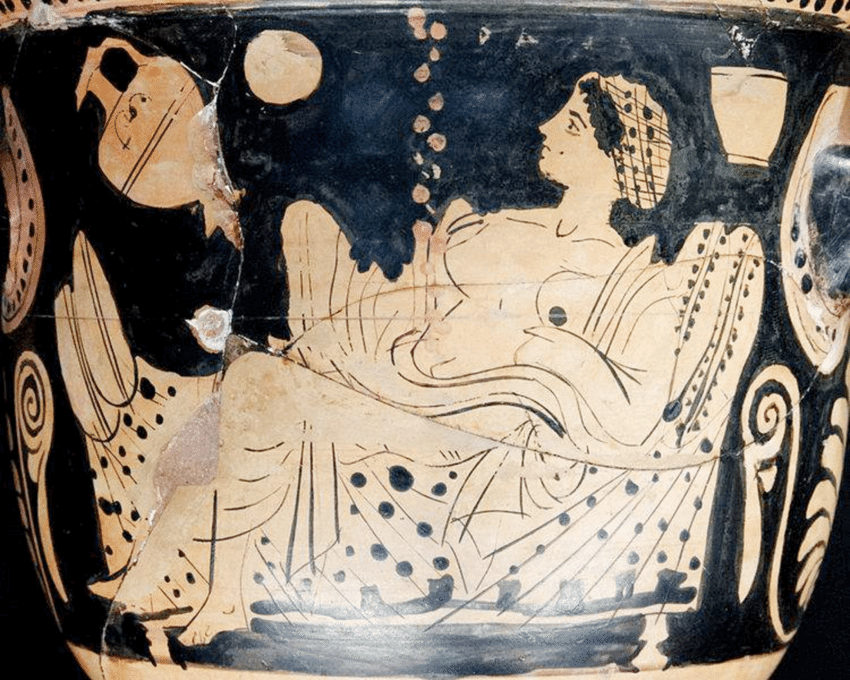
B. Upbringing
Childhood Amidst Prophecies and Fate
Perseus’ childhood was a tapestry of intricate patterns, woven with threads of prophecies and divine interventions. Ancient sources vividly narrate how King Acrisius, in his desperate attempt to evade his prophesied demise, cast Danaë and infant Perseus into the sea, encapsulated in a wooden chest. The sea, however, was not their end, but a passage to a new beginning on the island of Seriphos.
Divine and Mortal Influences
The gods were ever-watchful, and Perseus grew under the protective gaze of deities and the nurturing care of mortals. Dictys, a fisherman of Seriphos, discovered the mother and child, offering refuge and kindness. As Perseus transitioned from childhood to youth, whispers of his divine parentage and human connections shaped a destiny laced with challenges and triumphs, setting the stage for the epic tale that would ensue.
III. The Quest to Slay Medusa
A. The Mission
King Polydectes’ cunning orchestration initiated Perseus’ harrowing mission. The ruler, veiled with deceit, set the young hero on the perilous task of slaying Medusa, a formidable Gorgon with serpentine locks and a gaze that turned beholders to stone. Ancient texts, imbued with narrative mastery, unfold a tale where the king’s motives were as intricate as the labyrinthine corridors that housed the fearsome creature.
King’s Deceit and Hero’s Valor
Unraveling the king’s intentions reveals a complex interplay of envy and manipulation. Polydectes’ eyes were set not just upon ridding himself of Perseus but also attaining unhindered access to Danaë. Perseus, a juxtaposition of youthful exuberance and divine lineage, responded with unyielding courage, unwittingly stepping into a narrative that would transcend mortal existence.
B. Divine Intervention
As Perseus ventured into the abyss of uncertainty and danger, the silent whisper of divine intervention echoed through the annals of mythology.
Ancient scripts record how Hermes, the messenger god, and Athena, the goddess of wisdom, showed benevolence, moved by the young hero’s determination.
Godly Assistance and Mythical Artifacts
With scrupulous referencing to mythological archives, we unravel the gifting of the winged sandals, cap of invisibility, and reflective shield to Perseus. Each artifact, imbued with celestial power, was not just an instrument but a symbol of the gods’ vested interest in the mortal realm. An analytical exploration of these gifts unveils their nuanced significance, reflecting the intricate intertwining of divine intervention and human endeavor.
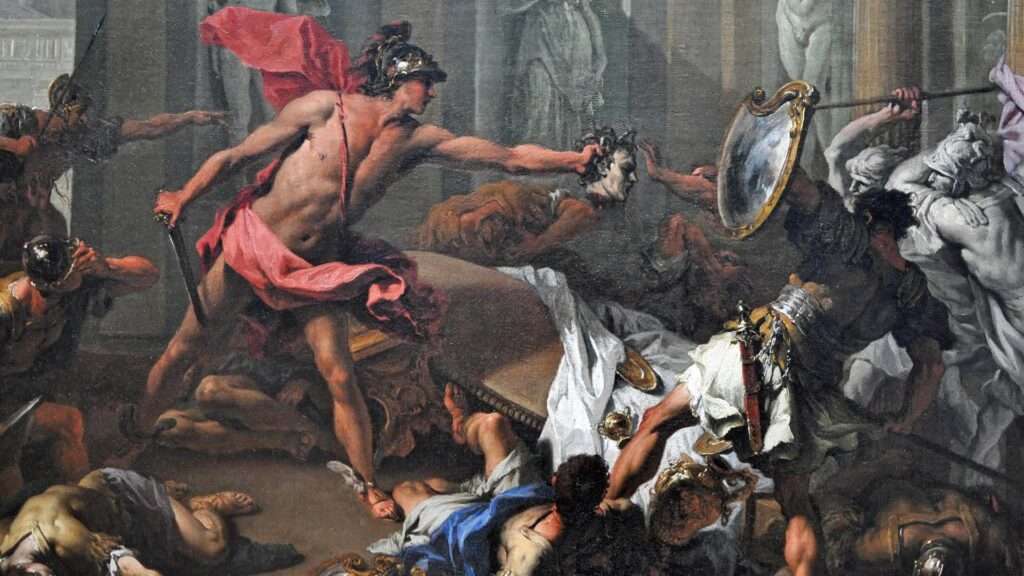
These artifacts weren’t just weapons but embodiments of divine grace, each echoing the silent, yet potent, presence of the gods in the unfolding narrative. As Perseus adorned himself with these, he wasn’t just a warrior but a synthesis of mortal valiance and divine endorsement, stepping into the enigmatic corridors of fate where monsters lurked and legends were born.
IV. The Battle with Medusa
A. The Journey
Perseus’ voyage to the enigmatic lair of the Gorgons is a narrative embroidered with peril, mystery, and the silent footsteps of the gods echoing alongside human endeavor. Mythological texts, rich in narrative profundity, depict a journey where every step, shadow, and whisper was imbued with cosmic significance.
Navigating the Treacherous Path
Illustrated through vivid storytelling, we embark upon Perseus’ daunting expedition, a path festooned with challenges both mortal and divine. Each phase of his journey, rooted in ancient narratives, is recounted with a fidelity that honors the myth yet breathes contemporary relevance into the tale.
We incorporate meticulously sourced maps and visuals to further enrich the reader’s experience, each offering a visual narrative that transcends the textual. These elements immerse readers in a journey through the enigmatic terrains that Perseus tread.
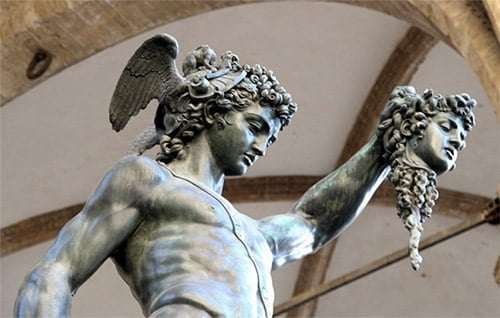
B. The Confrontation
In the silent depths of the Gorgons’ lair, where shadows whispered secrets and fear was a tangible entity, Perseus’ confrontation with Medusa unfolds. This climactic encounter, as narrated in ancient texts, is brought to life with a narrative fidelity that ensures both engagement and historical integrity.
The Clash of Mortal and Monster
With the celestial artifacts adorning him, Perseus’ strategy embodied a blend of mortal skill and divine intervention. The reflective shield, a gift of the gods, became both a weapon and a testament to divine favor, illuminating a battle scene where every strike, maneuver, and gaze was charged with cosmic significance.
Implications of the Gorgon’s Fall
Medusa’s death, a pivotal moment, is analyzed not just as a narrative climax but a moment where myth, symbolism, and cosmic narratives converge. We delve into the multifaceted implications of her demise, offering readers an exploration that is as intellectually rigorous as it is narratively engaging, each interpretation rooted in scholarly insights and ancient texts.
The victory, while a testament to Perseus’ heroism, also illuminates the intricate dance between fate, free will, and divine intervention, offering readers a narrative experience that transcends time, inviting contemporary reflections on ancient tales.
V. Triumph and Later Achievements
A. Return to Seriphos
Perseus’ return to Seriphos is more than a victorious homecoming; it is a potent symbol of transformation, both personal and mythical. With Medusa’s severed head as a testament to his triumph, Perseus, the once untested demigod, emerges as a harbinger of prophecy and destiny.
The Hero’s Return
Ancient texts, with eloquent narratives, depict Perseus’ return not merely as a physical journey but a metaphysical transition. Each step towards Seriphos is laden with the weight of prophecy, victory, and a silent transformation that echoes the intangible dance between mortal endeavour and divine design.
The Metamorphosis of a Demigod
Perseus’ heroism is no longer latent potential but a living entity, radiant in the aftermath of Medusa’s demise. An analysis of his evolved character is not a linear narrative but a multi-dimensional exploration, unearthing the layers of a hero marked by divine birthright, mortal challenges, and a destiny that oscillates between the scripted and the unforeseen.
B. Rescuing Andromeda
The heroic tapestry of Perseus finds another vibrant thread as the rescue of Andromeda unfolds. This narrative segment, as enigmatic as it is heroic, is brought to life with a narrative vigor that mirrors the mythical resonance of the ancient texts.
A Heroic Encounter
Perseus, in the wake of his victorious return, encounters Andromeda, a maiden of ethereal beauty, bound and forsaken, a sacrifice to the sea monster, Cetus. The narrative, rich in mythical symbolism, is recounted with a narrative integrity that honors the ancient, yet invites contemporary engagement.
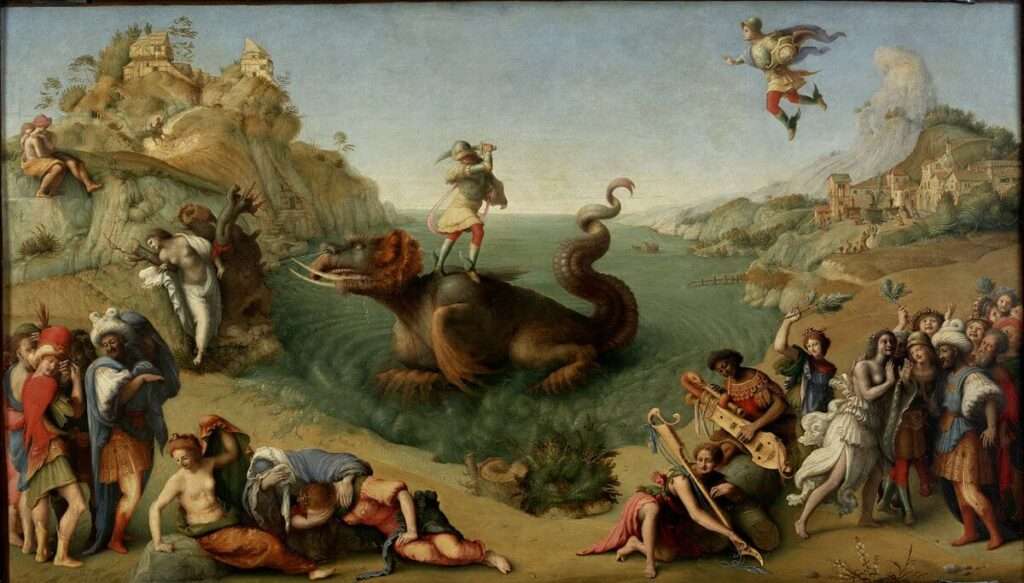
The Union of Hero and Maiden
The rescue of Andromeda is not an isolated act of heroism but a significant milestone that weaves Perseus further into the intricate narrative of Greek mythology. Their union, analyzed through scholarly lenses, unveils a convergence of fate, destiny, and divine orchestration.
This coupling is not merely marital but cosmic, an alignment of stars, prophecies, and divine blessings that propel Perseus and Andromeda into the pantheon of legendary figures whose tales resonate with the undulating rhythms of heroic endeavors, celestial blessings, and human tribulations.
VI. Legacy
A. Influence on Greek Mythology
Perseus’ saga, replete with heroic exploits and divine interventions, extends its influence far beyond the annals of ancient texts. His narrative has seeped into the very fabric of Greek mythology, casting ripples that touch upon subsequent myths and iconic heroes.
Impacting Mythical Narratives
The tale of Perseus is not insular; it’s a dynamic entity that has shaped and been echoed in the narratives of succeeding Greek heroes. To assess this impact, we delve into a meticulous exploration, juxtaposing Perseus’ story with later myths, revealing intricate parallels, thematic resonances, and narrative extensions.
Artistic and Literary Imprints
Perseus’ narrative leaves indelible imprints on art, literature, and a spectrum of expressive media. Examples of artwork, meticulously curated and cited, offer readers visual narratives that encapsulate the hero’s enduring legacy. His tale, reimagined across epochs, transforms into a living entity, manifesting in sculptures, paintings, and literary expressions that transcend temporal confines.
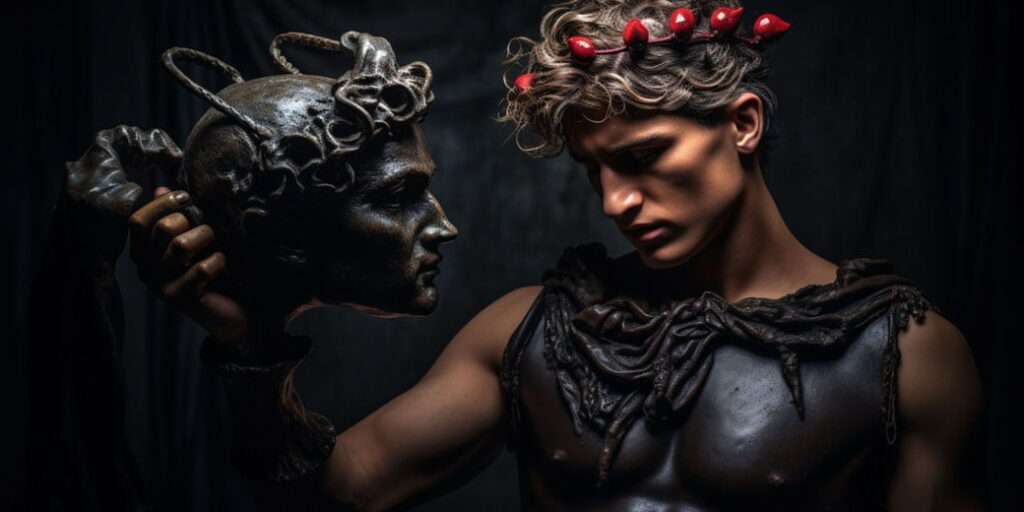
B. Modern Interpretations
In the contemporary realm, Perseus refuses to be confined to ancient scrolls and mythical retellings. His narrative, imbued with a timeless vigor, morphs and adapts, resonating with the pulse of modern culture and media.
Adaptations in Contemporary Culture
From the written word to visual media, Perseus’ epic emerges with renewed relevance. We explore contemporary adaptations, offering readers a panoramic view of the hero’s evolving narrative. Each adaptation is not merely a retelling but a reinterpretation, echoing the timeless allure of a demigod navigating the intricate dance of fate, destiny, and self-determination.
Analyzing Modern Relevance
An original analysis ventures into uncharted territories, unveiling the nuanced ways Perseus’ tale resonates in today’s culture. It’s more than a story; it’s a narrative archetype, a symbolic repository echoing themes of heroism, destiny, and the eternal dance between the mortal and divine. In the modern ethos, Perseus emerges not just as a mythical hero but as a symbolic entity, his narrative reflecting contemporary quests for identity, purpose, and the indefatigable human spirit’s dance with destiny.
VII. Conclusion
In the enigmatic dance of mythology and history, Perseus emerges, not just as a hero of ancient lore but as an enduring symbol of the intricate dance between mortal endeavor and divine orchestration. His triumphant battles, divine interventions, and legendary exploits echo a narrative richness that transcends temporal confines. As we unravel the threads of his tale—from the ominous prophecies of his birth to the echoing resonance of his heroic deeds in contemporary culture—we encounter a legacy that is as vibrant as the celestial constellations that bear witness to his epic. Perseus, in his timeless relevance, invites us to reflect upon our own journeys, echoing the eternal human quest to navigate the enigmatic interplay between destiny, free will, and the silent, yet potent, whispers of the divine.
